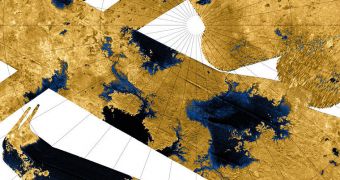Methane and ethane are the most basic hydrocarbons, but at the same time chemicals capable of arranging themselves into the most complex structures. Experts believe that, on Titan, these two elements have already set the foundation for the development of life.
This proposal takes into account the moon's chemistry, as well as data on its surface features and the cycles that control its air and land. It has seasons just like Earth, and features a complex atmosphere.
Lakes of liquid methane and ethane adorn both the north and south pole regions on Titan. The chemicals also permeate the air, and fall to the ground as rain. The NASA Cassini orbiter found that lightnings can occur as well.
For many years, exobiologists have believed that there is no way for complex organic molecules to form without the presence of liquid water. On the largest Saturnine moon, water is frozen so solid that it's harder to break than granite.
At this point, experts say, there are two main scenarios being circulate in the astronomical community. The first holds that microbial life already exists on Titan, while the second holds that the environment is simply primed for the first lifeforms to appear.
The low temperatures on the moon, which can reach minus 179 degrees Celsius (minus 290 degrees Fahrenheit), are the only aspect that may block the development of life on the surface. Yet, underground microbial communities remain a strong possibility.
But exploring Titan, or formulating theories about what may be going on on its surface and in its underground is a tricky task, say investigators at the University of Chicago.
“You have all these things that are analogous to Earth. At the same time, it's foreign and unfamiliar,” explains the UC Louis Block professor in geophysical sciences, Ray Pierrehumbert, as quoted by Daily Galaxy.
“One of the things that attracts me about Titan is that it has a lot of the same circulation features as Earth, but done with completely different substances that work at different temperatures,” he adds.
“The ironic thing on Titan is that although it's much colder than Earth, it actually acts like a super-hot Earth rather than a snowball Earth, because at Titan temperatures, methane is more volatile than water vapor is at Earth temperatures,” the expert reveals.
Despite its promise as a life-supporting environment, no mission is currently targeting the Saturnine moon directly. Plans to do so exist, of course, but no explorer is being built with the sole purpose of landing on this celestial body and exploring it thoroughly.

 14 DAY TRIAL //
14 DAY TRIAL //